Business Transactions Recording and Financial Statement Analysis
VerifiedAdded on 2022/12/28
|16
|2833
|74
Report
AI Summary
This report provides a comprehensive analysis of recording business transactions and their impact on financial performance. It begins with an introduction to business transactions and their importance, followed by a detailed examination of journal entries, ledger accounts, and the trial balance for Linda's business. The report then delves into the preparation of the profitability statement and balance sheet, interpreting the financial position of the business. A letter to Linda explains the concept of drawings in small businesses. Part B of the report focuses on ratio analysis, calculating and interpreting profitability, liquidity, and solvency ratios to assess Linda's financial performance and compare it to a competitor. The analysis highlights areas for improvement, such as reducing operating expenses, improving liquidity, and managing debtors and creditors effectively to enhance the financial health and long-term sustainability of the business.
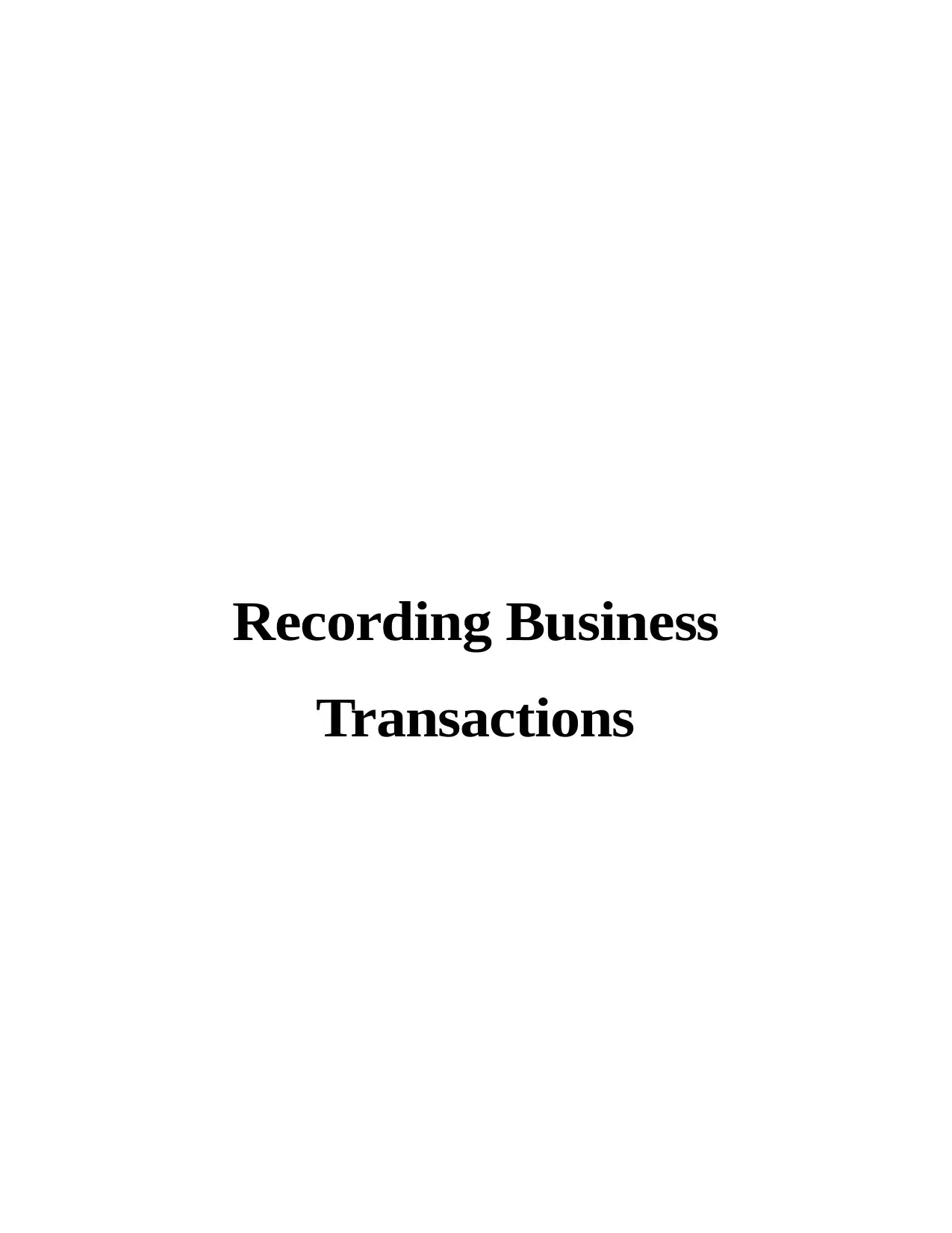
Recording Business
Transactions
Transactions
Paraphrase This Document
Need a fresh take? Get an instant paraphrase of this document with our AI Paraphraser
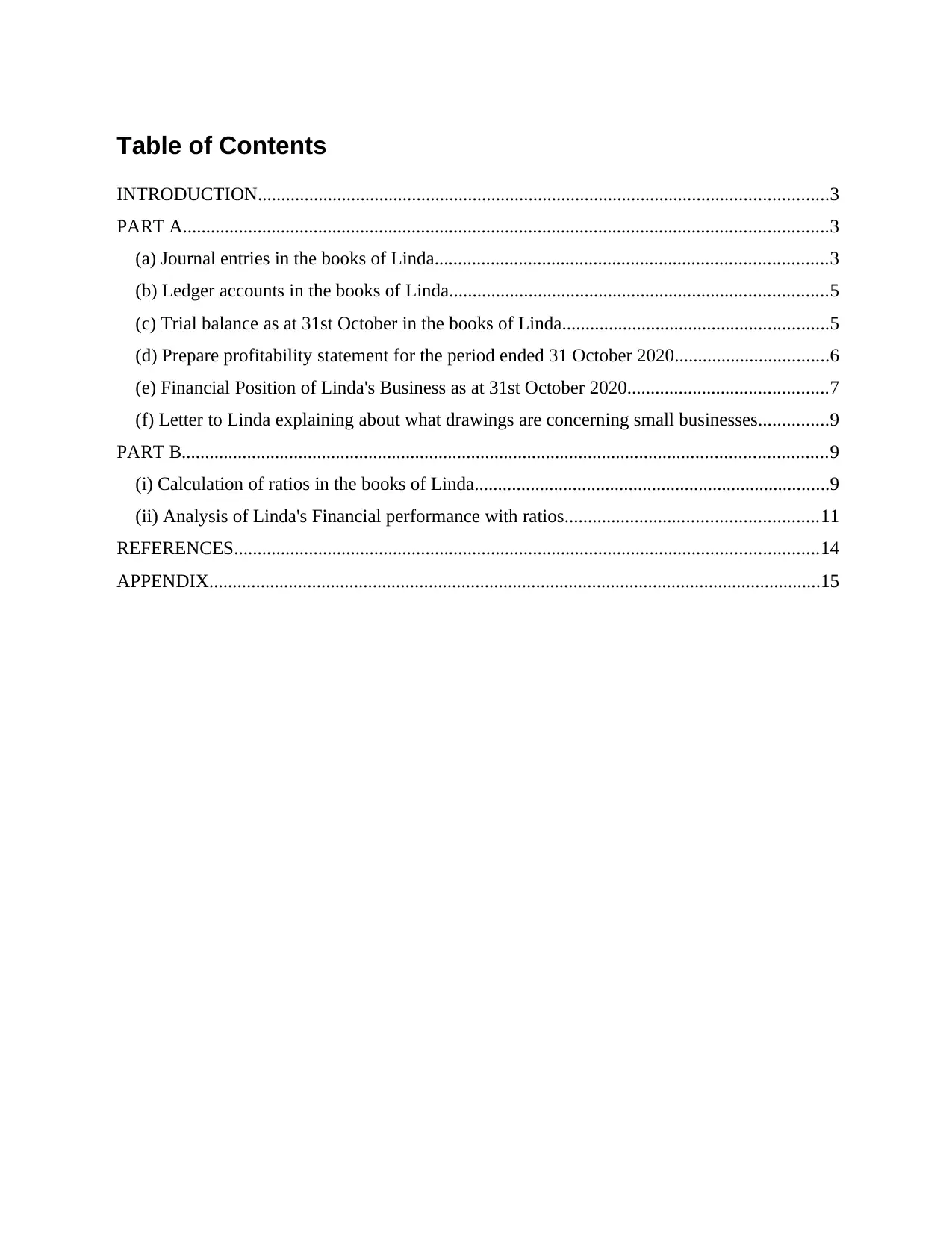
Table of Contents
INTRODUCTION..........................................................................................................................3
PART A..........................................................................................................................................3
(a) Journal entries in the books of Linda....................................................................................3
(b) Ledger accounts in the books of Linda.................................................................................5
(c) Trial balance as at 31st October in the books of Linda.........................................................5
(d) Prepare profitability statement for the period ended 31 October 2020.................................6
(e) Financial Position of Linda's Business as at 31st October 2020...........................................7
(f) Letter to Linda explaining about what drawings are concerning small businesses...............9
PART B..........................................................................................................................................9
(i) Calculation of ratios in the books of Linda............................................................................9
(ii) Analysis of Linda's Financial performance with ratios......................................................11
REFERENCES.............................................................................................................................14
APPENDIX...................................................................................................................................15
INTRODUCTION..........................................................................................................................3
PART A..........................................................................................................................................3
(a) Journal entries in the books of Linda....................................................................................3
(b) Ledger accounts in the books of Linda.................................................................................5
(c) Trial balance as at 31st October in the books of Linda.........................................................5
(d) Prepare profitability statement for the period ended 31 October 2020.................................6
(e) Financial Position of Linda's Business as at 31st October 2020...........................................7
(f) Letter to Linda explaining about what drawings are concerning small businesses...............9
PART B..........................................................................................................................................9
(i) Calculation of ratios in the books of Linda............................................................................9
(ii) Analysis of Linda's Financial performance with ratios......................................................11
REFERENCES.............................................................................................................................14
APPENDIX...................................................................................................................................15
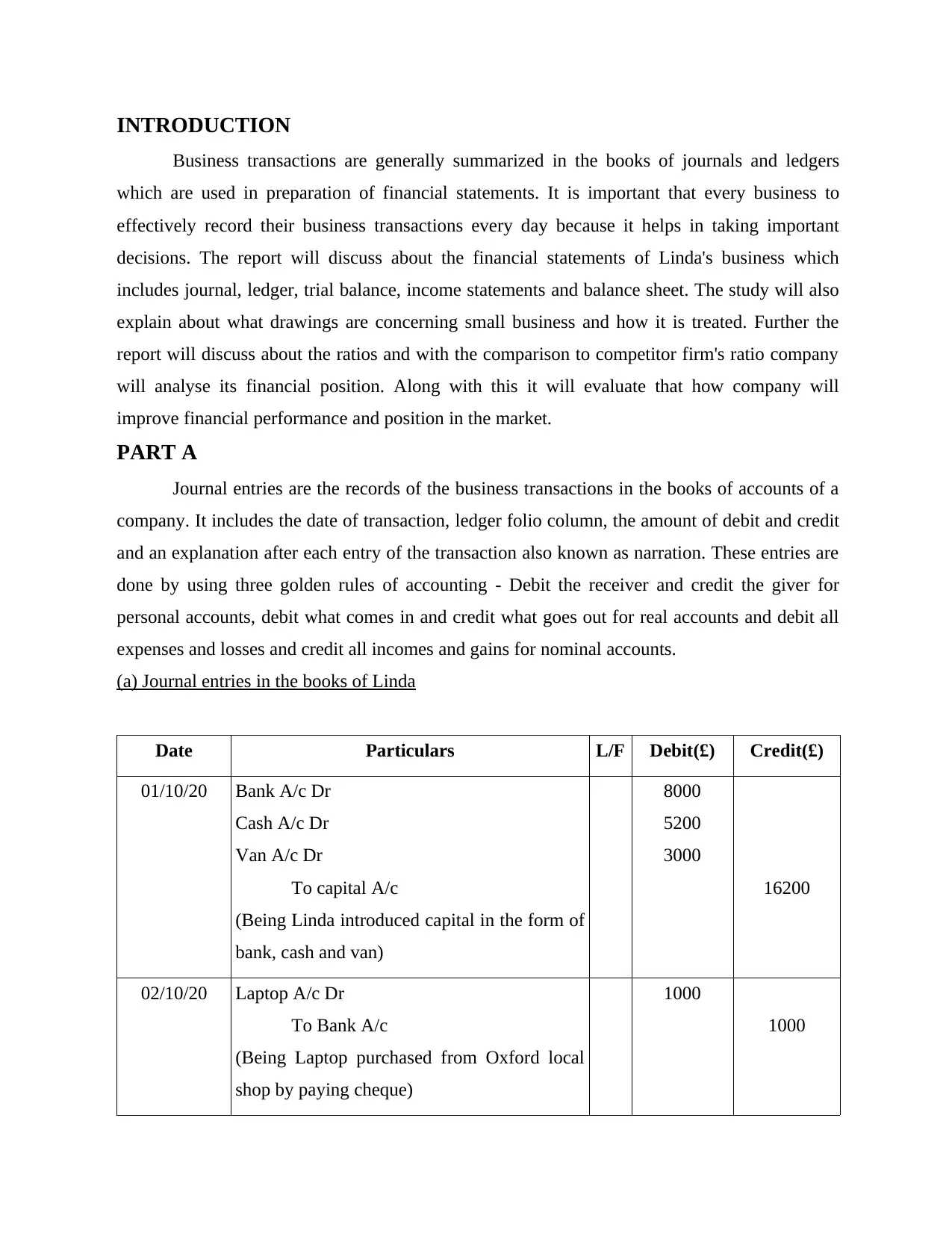
INTRODUCTION
Business transactions are generally summarized in the books of journals and ledgers
which are used in preparation of financial statements. It is important that every business to
effectively record their business transactions every day because it helps in taking important
decisions. The report will discuss about the financial statements of Linda's business which
includes journal, ledger, trial balance, income statements and balance sheet. The study will also
explain about what drawings are concerning small business and how it is treated. Further the
report will discuss about the ratios and with the comparison to competitor firm's ratio company
will analyse its financial position. Along with this it will evaluate that how company will
improve financial performance and position in the market.
PART A
Journal entries are the records of the business transactions in the books of accounts of a
company. It includes the date of transaction, ledger folio column, the amount of debit and credit
and an explanation after each entry of the transaction also known as narration. These entries are
done by using three golden rules of accounting - Debit the receiver and credit the giver for
personal accounts, debit what comes in and credit what goes out for real accounts and debit all
expenses and losses and credit all incomes and gains for nominal accounts.
(a) Journal entries in the books of Linda
Date Particulars L/F Debit(£) Credit(£)
01/10/20 Bank A/c Dr
Cash A/c Dr
Van A/c Dr
To capital A/c
(Being Linda introduced capital in the form of
bank, cash and van)
8000
5200
3000
16200
02/10/20 Laptop A/c Dr
To Bank A/c
(Being Laptop purchased from Oxford local
shop by paying cheque)
1000
1000
Business transactions are generally summarized in the books of journals and ledgers
which are used in preparation of financial statements. It is important that every business to
effectively record their business transactions every day because it helps in taking important
decisions. The report will discuss about the financial statements of Linda's business which
includes journal, ledger, trial balance, income statements and balance sheet. The study will also
explain about what drawings are concerning small business and how it is treated. Further the
report will discuss about the ratios and with the comparison to competitor firm's ratio company
will analyse its financial position. Along with this it will evaluate that how company will
improve financial performance and position in the market.
PART A
Journal entries are the records of the business transactions in the books of accounts of a
company. It includes the date of transaction, ledger folio column, the amount of debit and credit
and an explanation after each entry of the transaction also known as narration. These entries are
done by using three golden rules of accounting - Debit the receiver and credit the giver for
personal accounts, debit what comes in and credit what goes out for real accounts and debit all
expenses and losses and credit all incomes and gains for nominal accounts.
(a) Journal entries in the books of Linda
Date Particulars L/F Debit(£) Credit(£)
01/10/20 Bank A/c Dr
Cash A/c Dr
Van A/c Dr
To capital A/c
(Being Linda introduced capital in the form of
bank, cash and van)
8000
5200
3000
16200
02/10/20 Laptop A/c Dr
To Bank A/c
(Being Laptop purchased from Oxford local
shop by paying cheque)
1000
1000
⊘ This is a preview!⊘
Do you want full access?
Subscribe today to unlock all pages.

Trusted by 1+ million students worldwide
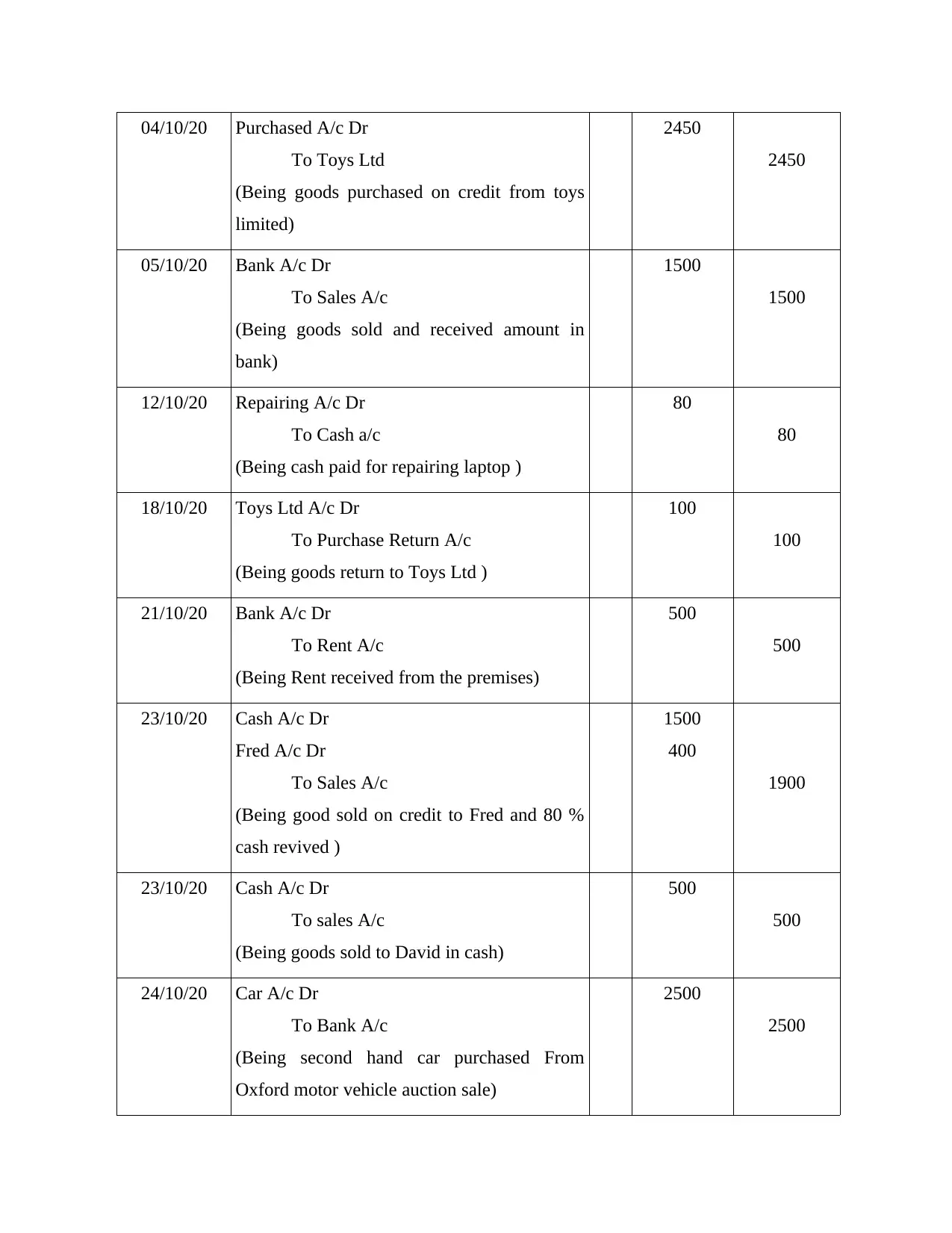
04/10/20 Purchased A/c Dr
To Toys Ltd
(Being goods purchased on credit from toys
limited)
2450
2450
05/10/20 Bank A/c Dr
To Sales A/c
(Being goods sold and received amount in
bank)
1500
1500
12/10/20 Repairing A/c Dr
To Cash a/c
(Being cash paid for repairing laptop )
80
80
18/10/20 Toys Ltd A/c Dr
To Purchase Return A/c
(Being goods return to Toys Ltd )
100
100
21/10/20 Bank A/c Dr
To Rent A/c
(Being Rent received from the premises)
500
500
23/10/20 Cash A/c Dr
Fred A/c Dr
To Sales A/c
(Being good sold on credit to Fred and 80 %
cash revived )
1500
400
1900
23/10/20 Cash A/c Dr
To sales A/c
(Being goods sold to David in cash)
500
500
24/10/20 Car A/c Dr
To Bank A/c
(Being second hand car purchased From
Oxford motor vehicle auction sale)
2500
2500
To Toys Ltd
(Being goods purchased on credit from toys
limited)
2450
2450
05/10/20 Bank A/c Dr
To Sales A/c
(Being goods sold and received amount in
bank)
1500
1500
12/10/20 Repairing A/c Dr
To Cash a/c
(Being cash paid for repairing laptop )
80
80
18/10/20 Toys Ltd A/c Dr
To Purchase Return A/c
(Being goods return to Toys Ltd )
100
100
21/10/20 Bank A/c Dr
To Rent A/c
(Being Rent received from the premises)
500
500
23/10/20 Cash A/c Dr
Fred A/c Dr
To Sales A/c
(Being good sold on credit to Fred and 80 %
cash revived )
1500
400
1900
23/10/20 Cash A/c Dr
To sales A/c
(Being goods sold to David in cash)
500
500
24/10/20 Car A/c Dr
To Bank A/c
(Being second hand car purchased From
Oxford motor vehicle auction sale)
2500
2500
Paraphrase This Document
Need a fresh take? Get an instant paraphrase of this document with our AI Paraphraser
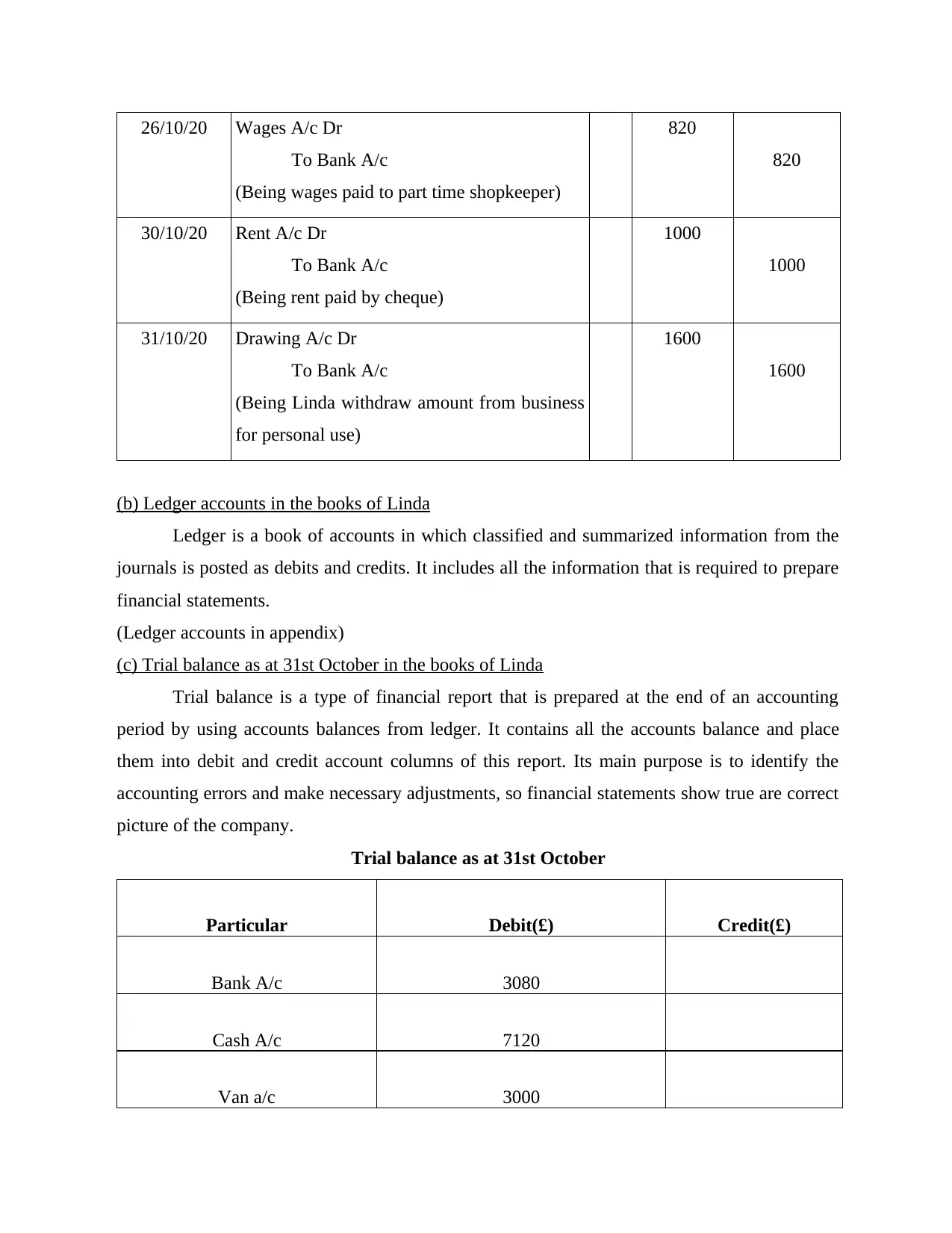
26/10/20 Wages A/c Dr
To Bank A/c
(Being wages paid to part time shopkeeper)
820
820
30/10/20 Rent A/c Dr
To Bank A/c
(Being rent paid by cheque)
1000
1000
31/10/20 Drawing A/c Dr
To Bank A/c
(Being Linda withdraw amount from business
for personal use)
1600
1600
(b) Ledger accounts in the books of Linda
Ledger is a book of accounts in which classified and summarized information from the
journals is posted as debits and credits. It includes all the information that is required to prepare
financial statements.
(Ledger accounts in appendix)
(c) Trial balance as at 31st October in the books of Linda
Trial balance is a type of financial report that is prepared at the end of an accounting
period by using accounts balances from ledger. It contains all the accounts balance and place
them into debit and credit account columns of this report. Its main purpose is to identify the
accounting errors and make necessary adjustments, so financial statements show true are correct
picture of the company.
Trial balance as at 31st October
Particular Debit(£) Credit(£)
Bank A/c 3080
Cash A/c 7120
Van a/c 3000
To Bank A/c
(Being wages paid to part time shopkeeper)
820
820
30/10/20 Rent A/c Dr
To Bank A/c
(Being rent paid by cheque)
1000
1000
31/10/20 Drawing A/c Dr
To Bank A/c
(Being Linda withdraw amount from business
for personal use)
1600
1600
(b) Ledger accounts in the books of Linda
Ledger is a book of accounts in which classified and summarized information from the
journals is posted as debits and credits. It includes all the information that is required to prepare
financial statements.
(Ledger accounts in appendix)
(c) Trial balance as at 31st October in the books of Linda
Trial balance is a type of financial report that is prepared at the end of an accounting
period by using accounts balances from ledger. It contains all the accounts balance and place
them into debit and credit account columns of this report. Its main purpose is to identify the
accounting errors and make necessary adjustments, so financial statements show true are correct
picture of the company.
Trial balance as at 31st October
Particular Debit(£) Credit(£)
Bank A/c 3080
Cash A/c 7120
Van a/c 3000
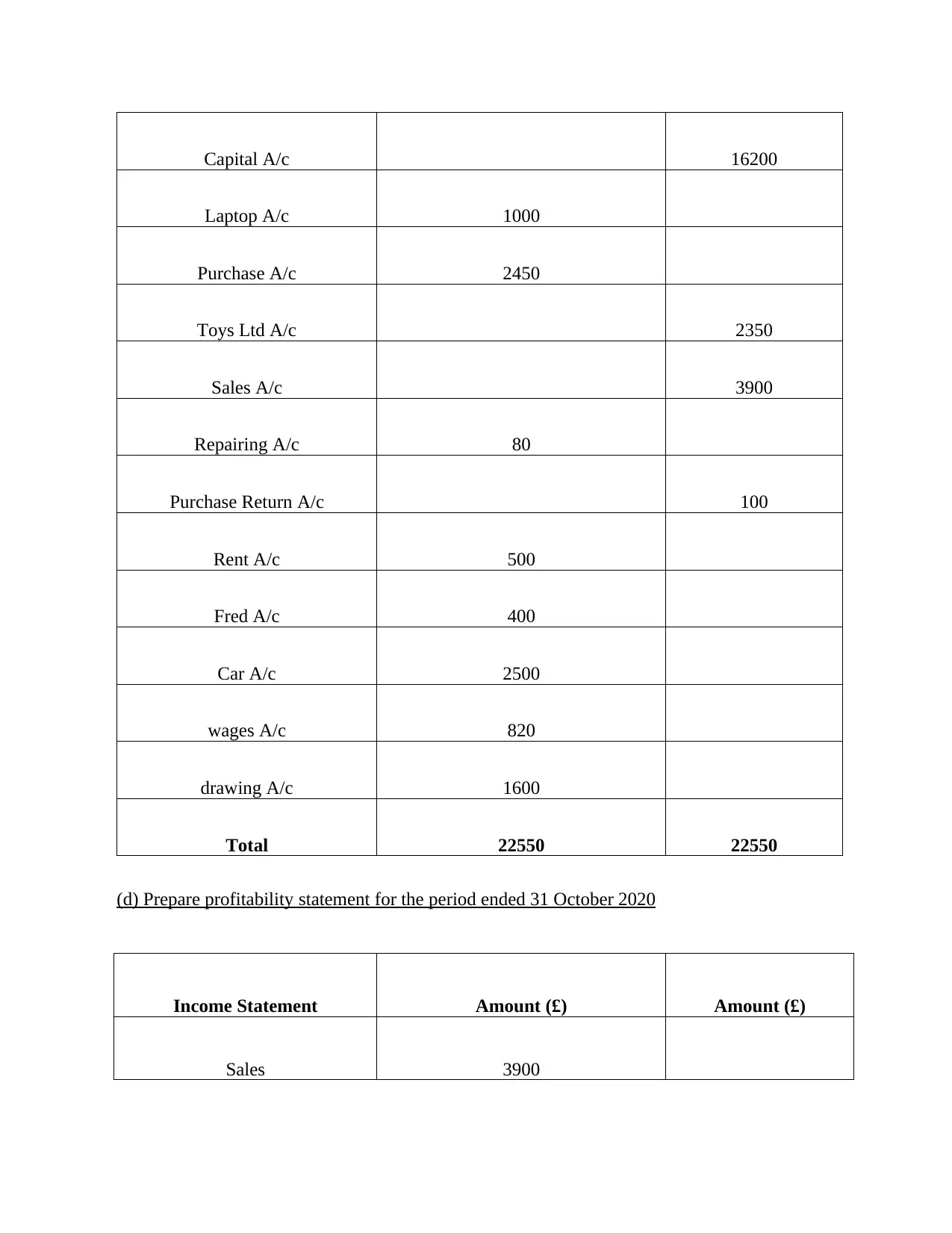
Capital A/c 16200
Laptop A/c 1000
Purchase A/c 2450
Toys Ltd A/c 2350
Sales A/c 3900
Repairing A/c 80
Purchase Return A/c 100
Rent A/c 500
Fred A/c 400
Car A/c 2500
wages A/c 820
drawing A/c 1600
Total 22550 22550
(d) Prepare profitability statement for the period ended 31 October 2020
Income Statement Amount (£) Amount (£)
Sales 3900
Laptop A/c 1000
Purchase A/c 2450
Toys Ltd A/c 2350
Sales A/c 3900
Repairing A/c 80
Purchase Return A/c 100
Rent A/c 500
Fred A/c 400
Car A/c 2500
wages A/c 820
drawing A/c 1600
Total 22550 22550
(d) Prepare profitability statement for the period ended 31 October 2020
Income Statement Amount (£) Amount (£)
Sales 3900
⊘ This is a preview!⊘
Do you want full access?
Subscribe today to unlock all pages.

Trusted by 1+ million students worldwide
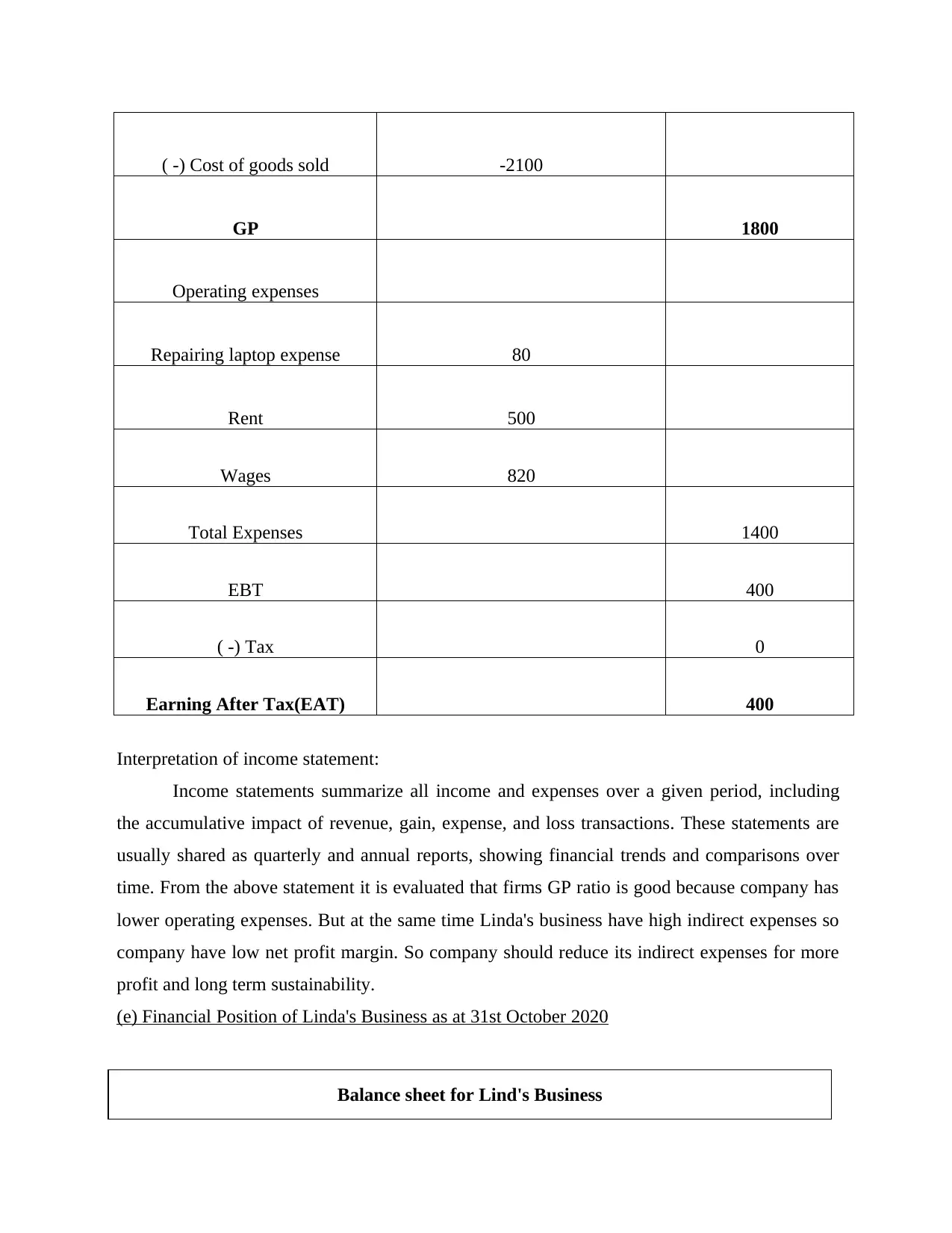
( -) Cost of goods sold -2100
GP 1800
Operating expenses
Repairing laptop expense 80
Rent 500
Wages 820
Total Expenses 1400
EBT 400
( -) Tax 0
Earning After Tax(EAT) 400
Interpretation of income statement:
Income statements summarize all income and expenses over a given period, including
the accumulative impact of revenue, gain, expense, and loss transactions. These statements are
usually shared as quarterly and annual reports, showing financial trends and comparisons over
time. From the above statement it is evaluated that firms GP ratio is good because company has
lower operating expenses. But at the same time Linda's business have high indirect expenses so
company have low net profit margin. So company should reduce its indirect expenses for more
profit and long term sustainability.
(e) Financial Position of Linda's Business as at 31st October 2020
Balance sheet for Lind's Business
GP 1800
Operating expenses
Repairing laptop expense 80
Rent 500
Wages 820
Total Expenses 1400
EBT 400
( -) Tax 0
Earning After Tax(EAT) 400
Interpretation of income statement:
Income statements summarize all income and expenses over a given period, including
the accumulative impact of revenue, gain, expense, and loss transactions. These statements are
usually shared as quarterly and annual reports, showing financial trends and comparisons over
time. From the above statement it is evaluated that firms GP ratio is good because company has
lower operating expenses. But at the same time Linda's business have high indirect expenses so
company have low net profit margin. So company should reduce its indirect expenses for more
profit and long term sustainability.
(e) Financial Position of Linda's Business as at 31st October 2020
Balance sheet for Lind's Business
Paraphrase This Document
Need a fresh take? Get an instant paraphrase of this document with our AI Paraphraser
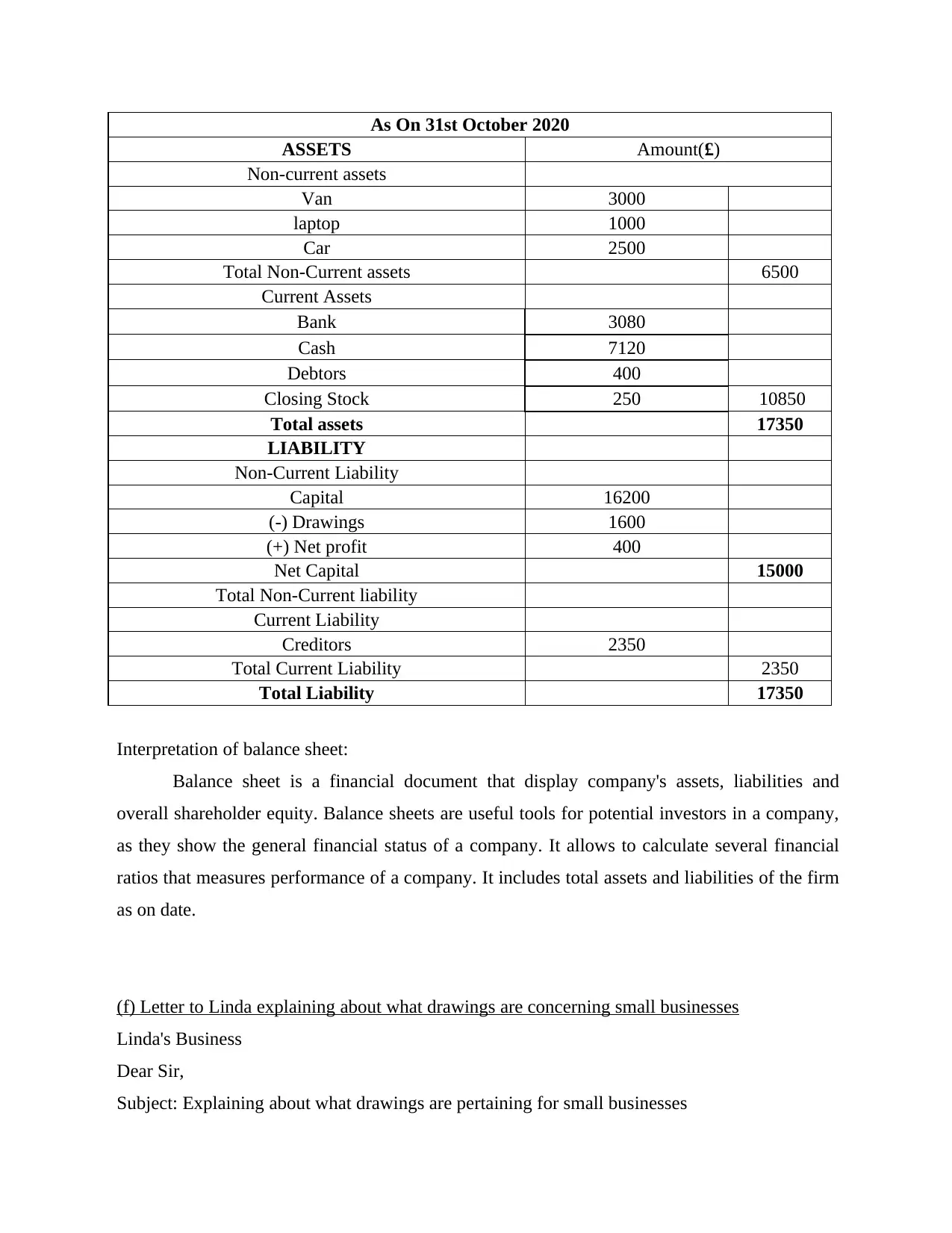
As On 31st October 2020
ASSETS Amount(£)
Non-current assets
Van 3000
laptop 1000
Car 2500
Total Non-Current assets 6500
Current Assets
Bank 3080
Cash 7120
Debtors 400
Closing Stock 250 10850
Total assets 17350
LIABILITY
Non-Current Liability
Capital 16200
(-) Drawings 1600
(+) Net profit 400
Net Capital 15000
Total Non-Current liability
Current Liability
Creditors 2350
Total Current Liability 2350
Total Liability 17350
Interpretation of balance sheet:
Balance sheet is a financial document that display company's assets, liabilities and
overall shareholder equity. Balance sheets are useful tools for potential investors in a company,
as they show the general financial status of a company. It allows to calculate several financial
ratios that measures performance of a company. It includes total assets and liabilities of the firm
as on date.
(f) Letter to Linda explaining about what drawings are concerning small businesses
Linda's Business
Dear Sir,
Subject: Explaining about what drawings are pertaining for small businesses
ASSETS Amount(£)
Non-current assets
Van 3000
laptop 1000
Car 2500
Total Non-Current assets 6500
Current Assets
Bank 3080
Cash 7120
Debtors 400
Closing Stock 250 10850
Total assets 17350
LIABILITY
Non-Current Liability
Capital 16200
(-) Drawings 1600
(+) Net profit 400
Net Capital 15000
Total Non-Current liability
Current Liability
Creditors 2350
Total Current Liability 2350
Total Liability 17350
Interpretation of balance sheet:
Balance sheet is a financial document that display company's assets, liabilities and
overall shareholder equity. Balance sheets are useful tools for potential investors in a company,
as they show the general financial status of a company. It allows to calculate several financial
ratios that measures performance of a company. It includes total assets and liabilities of the firm
as on date.
(f) Letter to Linda explaining about what drawings are concerning small businesses
Linda's Business
Dear Sir,
Subject: Explaining about what drawings are pertaining for small businesses
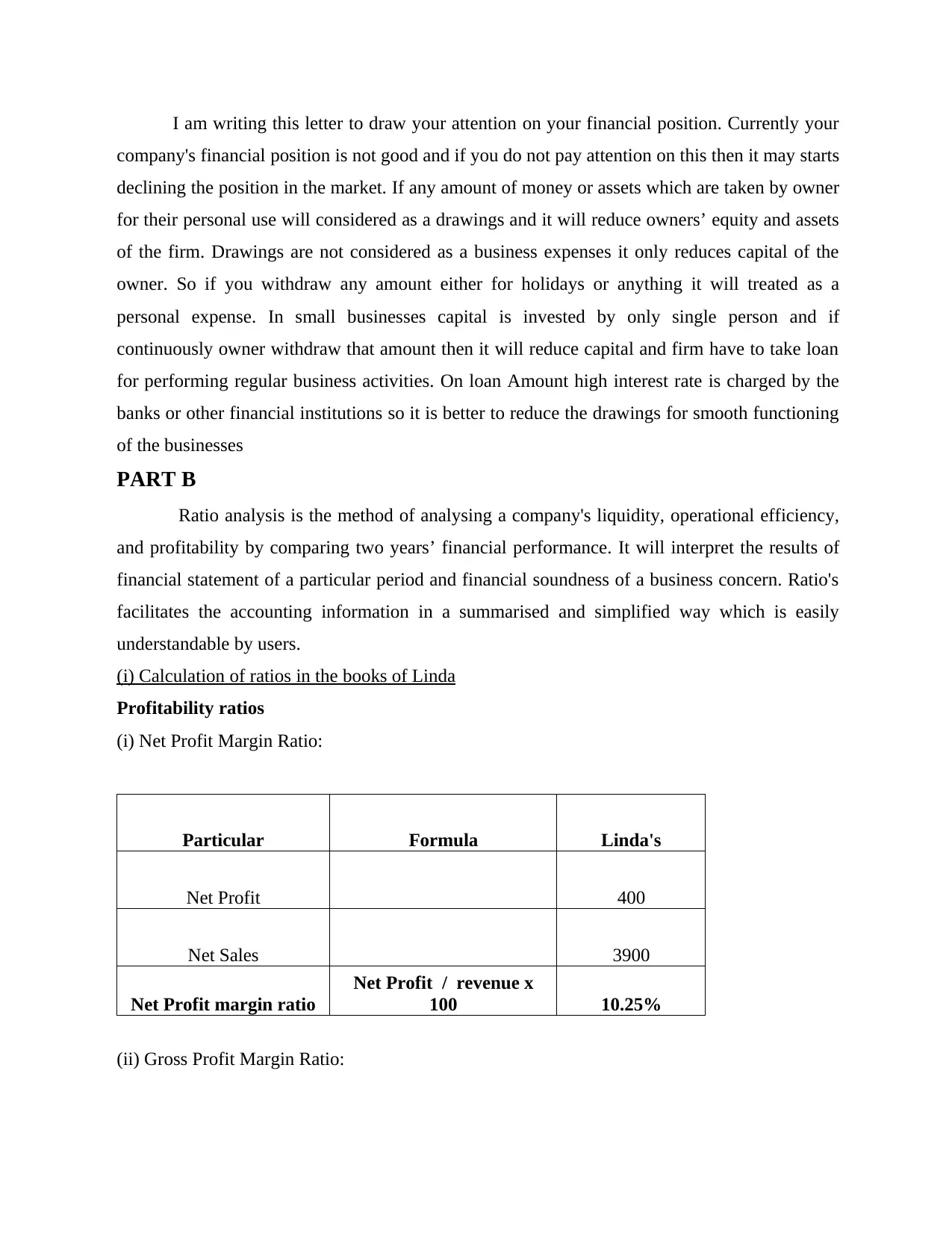
I am writing this letter to draw your attention on your financial position. Currently your
company's financial position is not good and if you do not pay attention on this then it may starts
declining the position in the market. If any amount of money or assets which are taken by owner
for their personal use will considered as a drawings and it will reduce owners’ equity and assets
of the firm. Drawings are not considered as a business expenses it only reduces capital of the
owner. So if you withdraw any amount either for holidays or anything it will treated as a
personal expense. In small businesses capital is invested by only single person and if
continuously owner withdraw that amount then it will reduce capital and firm have to take loan
for performing regular business activities. On loan Amount high interest rate is charged by the
banks or other financial institutions so it is better to reduce the drawings for smooth functioning
of the businesses
PART B
Ratio analysis is the method of analysing a company's liquidity, operational efficiency,
and profitability by comparing two years’ financial performance. It will interpret the results of
financial statement of a particular period and financial soundness of a business concern. Ratio's
facilitates the accounting information in a summarised and simplified way which is easily
understandable by users.
(i) Calculation of ratios in the books of Linda
Profitability ratios
(i) Net Profit Margin Ratio:
Particular Formula Linda's
Net Profit 400
Net Sales 3900
Net Profit margin ratio
Net Profit / revenue x
100 10.25%
(ii) Gross Profit Margin Ratio:
company's financial position is not good and if you do not pay attention on this then it may starts
declining the position in the market. If any amount of money or assets which are taken by owner
for their personal use will considered as a drawings and it will reduce owners’ equity and assets
of the firm. Drawings are not considered as a business expenses it only reduces capital of the
owner. So if you withdraw any amount either for holidays or anything it will treated as a
personal expense. In small businesses capital is invested by only single person and if
continuously owner withdraw that amount then it will reduce capital and firm have to take loan
for performing regular business activities. On loan Amount high interest rate is charged by the
banks or other financial institutions so it is better to reduce the drawings for smooth functioning
of the businesses
PART B
Ratio analysis is the method of analysing a company's liquidity, operational efficiency,
and profitability by comparing two years’ financial performance. It will interpret the results of
financial statement of a particular period and financial soundness of a business concern. Ratio's
facilitates the accounting information in a summarised and simplified way which is easily
understandable by users.
(i) Calculation of ratios in the books of Linda
Profitability ratios
(i) Net Profit Margin Ratio:
Particular Formula Linda's
Net Profit 400
Net Sales 3900
Net Profit margin ratio
Net Profit / revenue x
100 10.25%
(ii) Gross Profit Margin Ratio:
⊘ This is a preview!⊘
Do you want full access?
Subscribe today to unlock all pages.

Trusted by 1+ million students worldwide
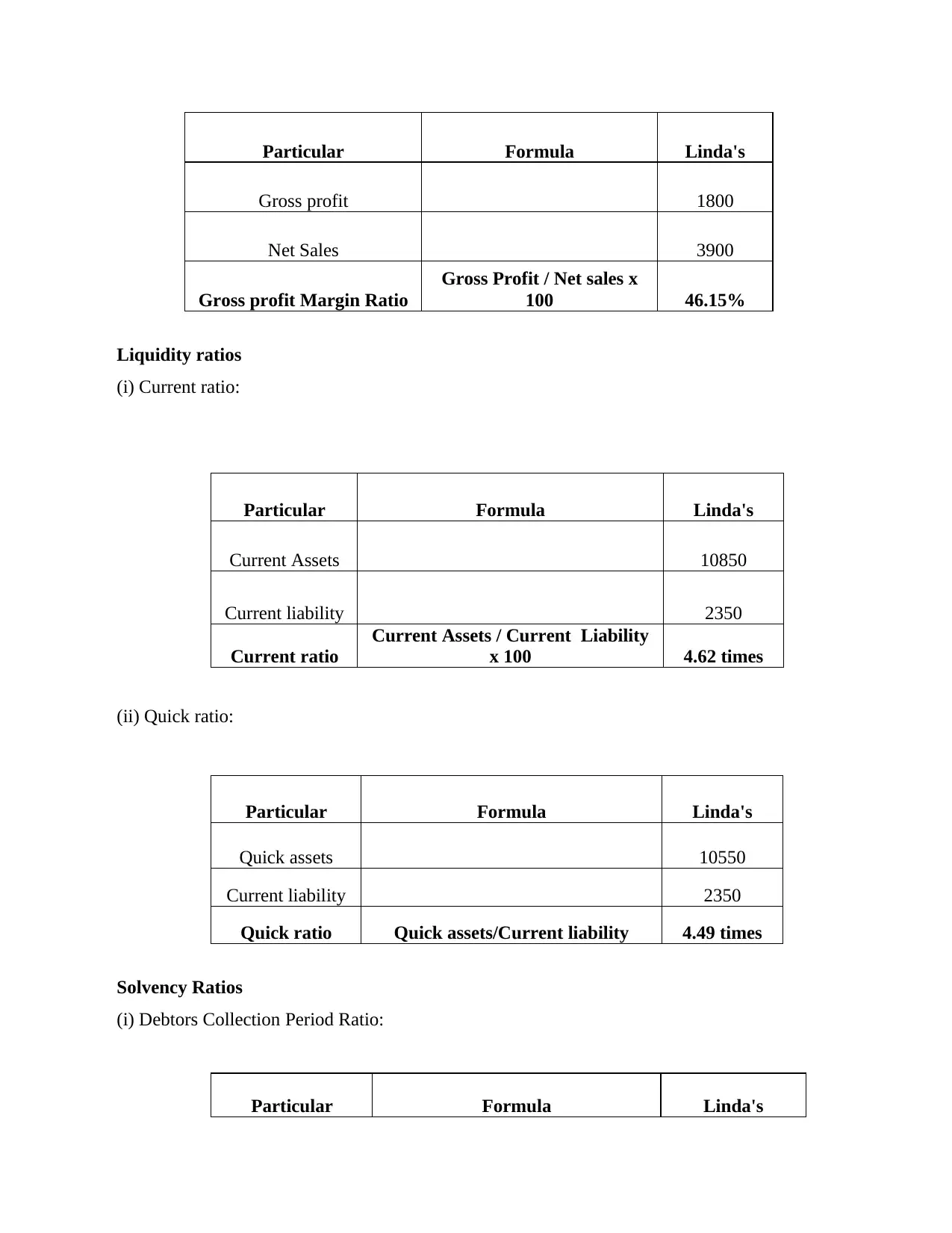
Particular Formula Linda's
Gross profit 1800
Net Sales 3900
Gross profit Margin Ratio
Gross Profit / Net sales x
100 46.15%
Liquidity ratios
(i) Current ratio:
Particular Formula Linda's
Current Assets 10850
Current liability 2350
Current ratio
Current Assets / Current Liability
x 100 4.62 times
(ii) Quick ratio:
Particular Formula Linda's
Quick assets 10550
Current liability 2350
Quick ratio Quick assets/Current liability 4.49 times
Solvency Ratios
(i) Debtors Collection Period Ratio:
Particular Formula Linda's
Gross profit 1800
Net Sales 3900
Gross profit Margin Ratio
Gross Profit / Net sales x
100 46.15%
Liquidity ratios
(i) Current ratio:
Particular Formula Linda's
Current Assets 10850
Current liability 2350
Current ratio
Current Assets / Current Liability
x 100 4.62 times
(ii) Quick ratio:
Particular Formula Linda's
Quick assets 10550
Current liability 2350
Quick ratio Quick assets/Current liability 4.49 times
Solvency Ratios
(i) Debtors Collection Period Ratio:
Particular Formula Linda's
Paraphrase This Document
Need a fresh take? Get an instant paraphrase of this document with our AI Paraphraser
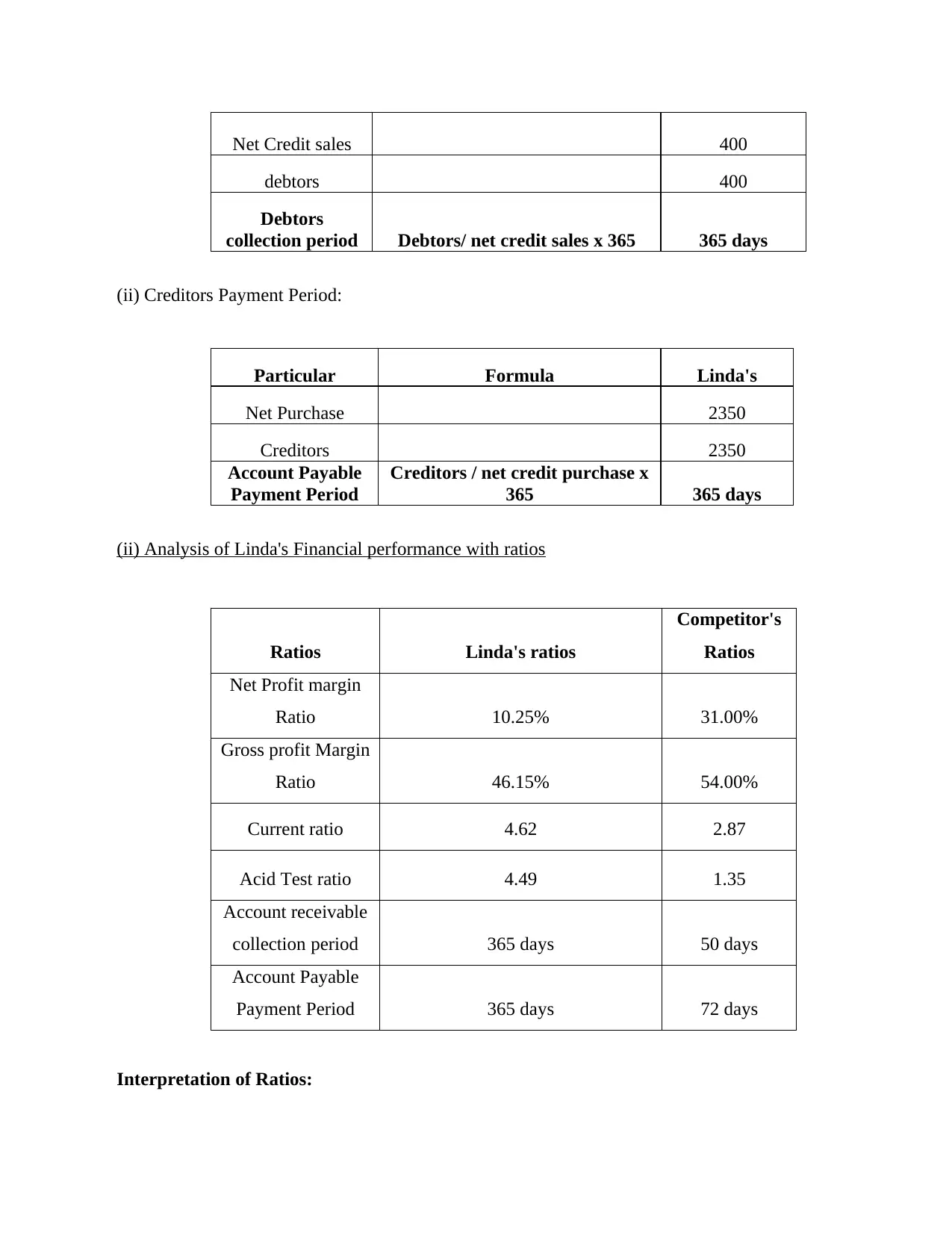
Net Credit sales 400
debtors 400
Debtors
collection period Debtors/ net credit sales x 365 365 days
(ii) Creditors Payment Period:
Particular Formula Linda's
Net Purchase 2350
Creditors 2350
Account Payable
Payment Period
Creditors / net credit purchase x
365 365 days
(ii) Analysis of Linda's Financial performance with ratios
Ratios Linda's ratios
Competitor's
Ratios
Net Profit margin
Ratio 10.25% 31.00%
Gross profit Margin
Ratio 46.15% 54.00%
Current ratio 4.62 2.87
Acid Test ratio 4.49 1.35
Account receivable
collection period 365 days 50 days
Account Payable
Payment Period 365 days 72 days
Interpretation of Ratios:
debtors 400
Debtors
collection period Debtors/ net credit sales x 365 365 days
(ii) Creditors Payment Period:
Particular Formula Linda's
Net Purchase 2350
Creditors 2350
Account Payable
Payment Period
Creditors / net credit purchase x
365 365 days
(ii) Analysis of Linda's Financial performance with ratios
Ratios Linda's ratios
Competitor's
Ratios
Net Profit margin
Ratio 10.25% 31.00%
Gross profit Margin
Ratio 46.15% 54.00%
Current ratio 4.62 2.87
Acid Test ratio 4.49 1.35
Account receivable
collection period 365 days 50 days
Account Payable
Payment Period 365 days 72 days
Interpretation of Ratios:
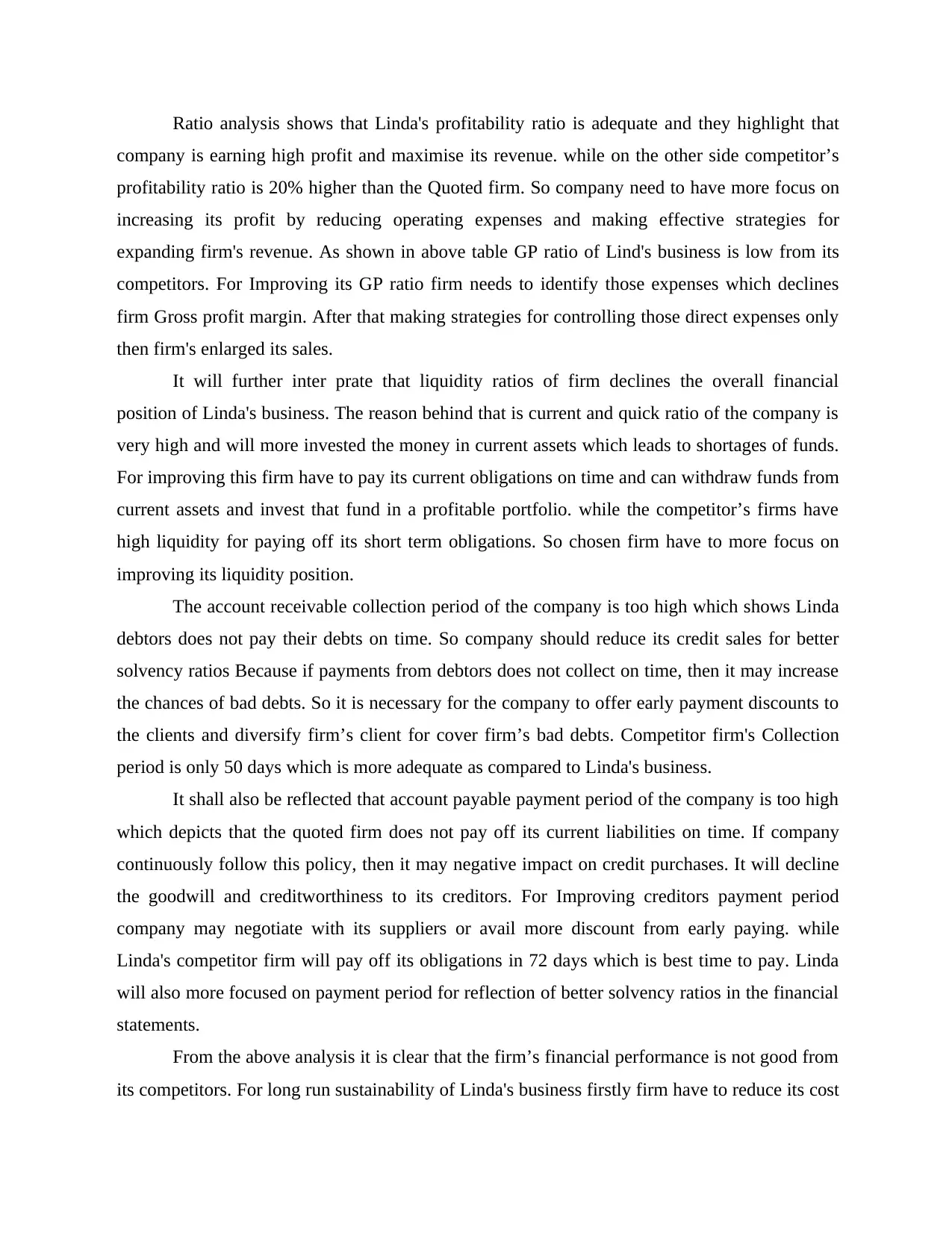
Ratio analysis shows that Linda's profitability ratio is adequate and they highlight that
company is earning high profit and maximise its revenue. while on the other side competitor’s
profitability ratio is 20% higher than the Quoted firm. So company need to have more focus on
increasing its profit by reducing operating expenses and making effective strategies for
expanding firm's revenue. As shown in above table GP ratio of Lind's business is low from its
competitors. For Improving its GP ratio firm needs to identify those expenses which declines
firm Gross profit margin. After that making strategies for controlling those direct expenses only
then firm's enlarged its sales.
It will further inter prate that liquidity ratios of firm declines the overall financial
position of Linda's business. The reason behind that is current and quick ratio of the company is
very high and will more invested the money in current assets which leads to shortages of funds.
For improving this firm have to pay its current obligations on time and can withdraw funds from
current assets and invest that fund in a profitable portfolio. while the competitor’s firms have
high liquidity for paying off its short term obligations. So chosen firm have to more focus on
improving its liquidity position.
The account receivable collection period of the company is too high which shows Linda
debtors does not pay their debts on time. So company should reduce its credit sales for better
solvency ratios Because if payments from debtors does not collect on time, then it may increase
the chances of bad debts. So it is necessary for the company to offer early payment discounts to
the clients and diversify firm’s client for cover firm’s bad debts. Competitor firm's Collection
period is only 50 days which is more adequate as compared to Linda's business.
It shall also be reflected that account payable payment period of the company is too high
which depicts that the quoted firm does not pay off its current liabilities on time. If company
continuously follow this policy, then it may negative impact on credit purchases. It will decline
the goodwill and creditworthiness to its creditors. For Improving creditors payment period
company may negotiate with its suppliers or avail more discount from early paying. while
Linda's competitor firm will pay off its obligations in 72 days which is best time to pay. Linda
will also more focused on payment period for reflection of better solvency ratios in the financial
statements.
From the above analysis it is clear that the firm’s financial performance is not good from
its competitors. For long run sustainability of Linda's business firstly firm have to reduce its cost
company is earning high profit and maximise its revenue. while on the other side competitor’s
profitability ratio is 20% higher than the Quoted firm. So company need to have more focus on
increasing its profit by reducing operating expenses and making effective strategies for
expanding firm's revenue. As shown in above table GP ratio of Lind's business is low from its
competitors. For Improving its GP ratio firm needs to identify those expenses which declines
firm Gross profit margin. After that making strategies for controlling those direct expenses only
then firm's enlarged its sales.
It will further inter prate that liquidity ratios of firm declines the overall financial
position of Linda's business. The reason behind that is current and quick ratio of the company is
very high and will more invested the money in current assets which leads to shortages of funds.
For improving this firm have to pay its current obligations on time and can withdraw funds from
current assets and invest that fund in a profitable portfolio. while the competitor’s firms have
high liquidity for paying off its short term obligations. So chosen firm have to more focus on
improving its liquidity position.
The account receivable collection period of the company is too high which shows Linda
debtors does not pay their debts on time. So company should reduce its credit sales for better
solvency ratios Because if payments from debtors does not collect on time, then it may increase
the chances of bad debts. So it is necessary for the company to offer early payment discounts to
the clients and diversify firm’s client for cover firm’s bad debts. Competitor firm's Collection
period is only 50 days which is more adequate as compared to Linda's business.
It shall also be reflected that account payable payment period of the company is too high
which depicts that the quoted firm does not pay off its current liabilities on time. If company
continuously follow this policy, then it may negative impact on credit purchases. It will decline
the goodwill and creditworthiness to its creditors. For Improving creditors payment period
company may negotiate with its suppliers or avail more discount from early paying. while
Linda's competitor firm will pay off its obligations in 72 days which is best time to pay. Linda
will also more focused on payment period for reflection of better solvency ratios in the financial
statements.
From the above analysis it is clear that the firm’s financial performance is not good from
its competitors. For long run sustainability of Linda's business firstly firm have to reduce its cost
⊘ This is a preview!⊘
Do you want full access?
Subscribe today to unlock all pages.

Trusted by 1+ million students worldwide
1 out of 16
Related Documents
Your All-in-One AI-Powered Toolkit for Academic Success.
+13062052269
info@desklib.com
Available 24*7 on WhatsApp / Email
![[object Object]](/_next/static/media/star-bottom.7253800d.svg)
Unlock your academic potential
Copyright © 2020–2025 A2Z Services. All Rights Reserved. Developed and managed by ZUCOL.





